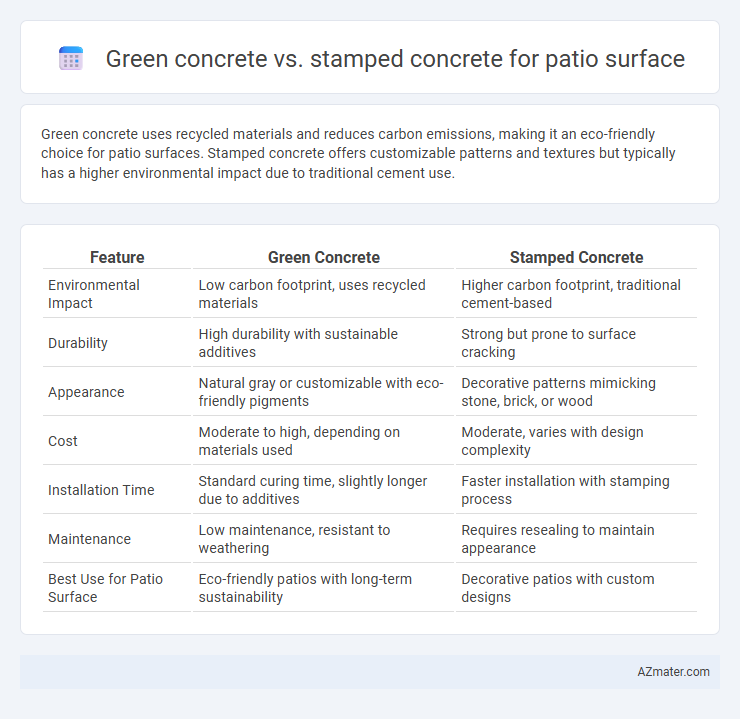Green concrete uses recycled materials and reduces carbon emissions, making it an eco-friendly choice for patio surfaces. Stamped concrete offers customizable patterns and textures but typically has a higher environmental impact due to traditional cement use.
Table of Comparison
| Feature | Green Concrete | Stamped Concrete |
|---|---|---|
| Environmental Impact | Low carbon footprint, uses recycled materials | Higher carbon footprint, traditional cement-based |
| Durability | High durability with sustainable additives | Strong but prone to surface cracking |
| Appearance | Natural gray or customizable with eco-friendly pigments | Decorative patterns mimicking stone, brick, or wood |
| Cost | Moderate to high, depending on materials used | Moderate, varies with design complexity |
| Installation Time | Standard curing time, slightly longer due to additives | Faster installation with stamping process |
| Maintenance | Low maintenance, resistant to weathering | Requires resealing to maintain appearance |
| Best Use for Patio Surface | Eco-friendly patios with long-term sustainability | Decorative patios with custom designs |
Introduction to Patio Surface Options
Green concrete uses eco-friendly materials and recycled aggregates to reduce environmental impact, making it an ideal choice for sustainable patio surfaces. Stamped concrete offers decorative patterns and textures that mimic natural stone or brick, providing aesthetic versatility and curb appeal. Both options balance durability and design, catering to different preferences in patio surface solutions.
What is Green Concrete?
Green concrete is an eco-friendly building material composed of recycled industrial waste such as fly ash, slag, and recycled aggregates, reducing CO2 emissions and conserving natural resources. Its energy-efficient production process minimizes environmental impact while providing comparable strength and durability to traditional concrete. This sustainable alternative is ideal for patio surfaces aiming to lower carbon footprints without compromising structural integrity.
What is Stamped Concrete?
Stamped concrete is a decorative concrete surface designed to mimic the appearance of materials like brick, stone, or wood through the use of patterned molds and color additives. It offers durability and versatility for patios, combining aesthetics with the strength of traditional concrete, while allowing customization in texture and color to suit outdoor design preferences. Compared to green concrete, which prioritizes environmental benefits, stamped concrete focuses on visual appeal and surface texture without inherently providing eco-friendly attributes.
Environmental Impact: Green vs Stamped Concrete
Green concrete significantly reduces environmental impact by incorporating recycled materials such as fly ash, slag, and reclaimed aggregates, which lower carbon emissions and conserve natural resources. Stamped concrete often uses traditional Portland cement, contributing to higher carbon footprints due to energy-intensive production processes and resource extraction. Choosing green concrete for a patio surface supports sustainable construction practices by minimizing greenhouse gas emissions and promoting eco-friendly material reuse.
Durability and Longevity Comparison
Green concrete incorporates recycled materials and eco-friendly additives, enhancing its durability while reducing environmental impact, making it highly resistant to weathering and chemical damage over time. Stamped concrete offers aesthetic versatility with textured patterns but can be prone to cracking and surface wear without proper sealing and maintenance. For patio surfaces, green concrete generally provides superior longevity due to its enhanced material composition and sustainability features.
Maintenance Requirements for Both Surfaces
Green concrete patios require minimal maintenance, as their eco-friendly materials resist cracking and shrinkage, reducing the need for frequent repairs or sealing. Stamped concrete surfaces demand regular sealing every 2-3 years to preserve their decorative patterns and prevent surface wear from weather exposure. Both surfaces benefit from routine cleaning, but stamped concrete is more susceptible to fading and chipping, increasing long-term upkeep costs compared to green concrete.
Aesthetic Appeal and Design Flexibility
Green concrete offers a natural, eco-friendly aesthetic with earthy tones that blend seamlessly into garden landscapes, promoting sustainable design. Stamped concrete stands out for its extensive design flexibility, replicating textures like stone, brick, or wood with customizable patterns and colors to match various architectural styles. Both options enhance patio surfaces, but stamped concrete provides greater visual versatility while green concrete emphasizes environmental harmony.
Cost Analysis: Green Concrete vs Stamped Concrete
Green concrete typically costs between $6 to $9 per square foot, leveraging recycled materials and eco-friendly components that reduce environmental impact while maintaining durability. Stamped concrete ranges from $8 to $18 per square foot, influenced by intricate patterns and color finishes that enhance aesthetic appeal but increase labor and material expenses. Choosing between green and stamped concrete for patios balances budget constraints with desired sustainability and decorative outcomes.
Installation Process Differences
Green concrete requires the use of recycled materials and eco-friendly additives, which may extend the curing time and necessitate skilled handling for proper mixture consistency and environmental compliance. Stamped concrete involves pouring standard or colored concrete followed by imprinting patterns and textures before the surface sets, demanding precise timing to achieve detailed and lasting designs. While green concrete installation emphasizes sustainability and material sourcing, stamped concrete prioritizes aesthetic finishing and craftsmanship during the stamping phase.
Which Patio Surface is Right for You?
Green concrete offers enhanced environmental benefits by incorporating recycled materials and reducing carbon emissions, making it ideal for eco-conscious homeowners. Stamped concrete provides customizable aesthetics with various patterns and textures, perfect for those prioritizing visual appeal and design flexibility. Choosing the right patio surface depends on whether sustainability or decorative finish aligns better with your outdoor living goals.

Infographic: Green concrete vs Stamped concrete for Patio surface
 azmater.com
azmater.com